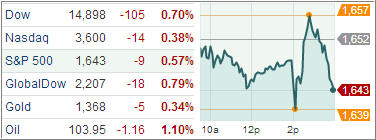Investors were anxiously waiting to see when the Fed would start to slow its $85 billion monthly asset purchases, with most predicting September as the beginning of the end of the aggressive quantitative easing program, known as QE4.
However, the Fed’s report offered no additional insight into the timing, keeping the taper anxiety of late intact. U.S. equities pared the losses that came immediately following the release of the minutes, but the bounce lost steam and stocks finished solidly lower.
Equities sold off in response to the Fed’s report, but the S&P followed the slide with a rally to fresh highs before returning into the red just ahead of the close. All ten sectors registered losses with rate-sensitive telecom services (-1.2%) and utilities (-1.2%) leading to the downside. Out of the ten sectors, only energy (-0.5%), health care (-0.5%), and technology (-0.1%) outperformed the broader market.
The tech sector held up relatively well and despite today’s loss, it is the only sector trading with an August gain (0.4%). Stocks were volatile with the CBOE Volatility Index jumped to its highest level since early July. Trading volume was the heaviest of the week, but still 11% lower than average.
In the biggest news of the day, the Fed minutes gave no clear signal. It showed that almost all participants were “broadly comfortable” with the contingent outlook for asset purchases that was given at the prior meeting in June.
Under that outlook, if economic conditions improved broadly as expected, the Committee would moderate the pace of purchases later this year and conclude the purchase program around the middle of 2014. However, the broader discussion showed some uncertainty among participants, with a number indicating less confidence in a growth rebound than they had been in June.
Treasuries moved lower following the report, despite a surprising jump in existing home sales, while mortgage applications saw their ninth-consecutive weekly decline.
Existing home sales rose 6.5% in July, the most in nearly three years, to a 5.39 million annual rate, the highest since November 2009, which was boosted by the homebuyer tax credit.
Economists predicted a rise of 6.1% to 5.15 million. Sales may have been accelerated on fears that mortgage rates will climb further in the months ahead. The 30-year mortgage is currently over 4.50%. Moreover, median prices continued to rise at a double-digit pace, up 13.7% from a year ago, the fastest pace since October 2005, to 213,500. Real median home prices are up a record 11.3% from a year ago. Distressed sales sold at a discount of roughly 14%.
Our Trend Tracking Indexes (TTIs) headed lower with the major indexes, as equities and bonds sank in unison. The Domestic TTI ended this volatile day at +1.27% while the International TTI closed at +4.33%.
Contact Ulli

